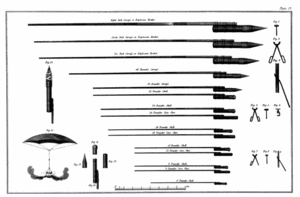Difference between revisions of "Anti-Dragon Weaponry"
(→Congreve Rocket) |
|||
| Line 3: | Line 3: | ||
==Congreve Rocket== | ==Congreve Rocket== | ||
| − | The '''Congreve Rocket''' was a [[British]] | + | The '''Congreve Rocket''' was a [[British Military]] weapon designed by [[William Congreve (inventor)|Sir William Congreve]] in 1804. |
[[Image:800px-Congreve rockets.gif|thumb|300px|Congreve Rockets]] | [[Image:800px-Congreve rockets.gif|thumb|300px|Congreve Rockets]] | ||
| Line 16: | Line 16: | ||
===Use=== | ===Use=== | ||
The rockets were effective in preventing aerial bombardment from dragons, as they were fired in batteries, putting up a screen of rocket fire against the dragons. They were also useful in bombardment against land targets, such as large groups of infantry or artillery. | The rockets were effective in preventing aerial bombardment from dragons, as they were fired in batteries, putting up a screen of rocket fire against the dragons. They were also useful in bombardment against land targets, such as large groups of infantry or artillery. | ||
| − | |||
==Pepper Gun== | ==Pepper Gun== | ||
Latest revision as of 23:53, 12 October 2008
Multiple types of weapons are employed on naval vessels, shore batteries, and in the field for use against dragons. They include rockets, pepper guns, harpoons, as well as musket fire and regular cannon fire using round- and cannister-shot. This article discusses primarily the specialized anti-dragon weaponry utilized by the militaries of the time.
Congreve Rocket[edit]
The Congreve Rocket was a British Military weapon designed by Sir William Congreve in 1804.
History[edit]
The British were greatly impressed by the Mysorean Rocket artillery made from iron tubes used by the armies of Tipu Sultan and his father, Haidar Ali. Tipu Sultan championed the use of mass attacks with rocket brigades in the army. The effect of these weapons on the British during the Second Anglo-Mysore War, Third Mysore War and Fourth Mysore War was sufficiently impressive to inspire William Congreve to develop his own rocket designs. Several Mysore rockets were sent to England, and after thoroughly examining the Indian specimens, from 1801, William Congreve, son of the Comptroller of the Royal Arsenal, Woolwich, London, set on a vigorous research and development programme at the Arsenal's laboratory. Congreve prepared a new propellant mixture, and developed a rocket motor with a strong iron tube with conical nose, weighing about 32 pounds (14.5 kilograms). The Royal Arsenal's first demonstration of solid fuel rockets was in 1805.
Design[edit]
The rocket was made up of an iron case of black powder for propulsion and a "cylindro-conoidal" warhead. The warheads were attached to wooden guide poles and were launched in pairs from half troughs on simple metal A-frames. The original rocket design had the guide pole side-mounted on the warhead, this was improved in 1815 with a base plate with a threaded hole. They could be fired up to two miles, the range being set by the degree of elevation of the launching frame, although at any range they were fairly inaccurate and had a tendency for premature explosion. They were as much a psychological weapon as a physical one, and they were rarely or never used except alongside other types of artillery. Congreve designed several different warhead sizes from 3 to 24 pounds. The 24 pound type with a fifteen foot guide pole was the most widely used variant. Different warheads were used, including explosive, shrapnel and incendiary.
Use[edit]
The rockets were effective in preventing aerial bombardment from dragons, as they were fired in batteries, putting up a screen of rocket fire against the dragons. They were also useful in bombardment against land targets, such as large groups of infantry or artillery.
Pepper Gun[edit]
The pepper gun is probably the simplest form of anti-dragon weapon for a military to use, as it can use regular cannons, but fires a cannister of pepper, which upon impact with the dragon, acts as a major irritant and can possibly blind the dragon, at least temporarily. Most naval and army cannons, though, do not have the elevation, so special mounts must be used to allow them to achieve the proper elevation to hit. They do not have very good range, and the dragon must be fairly close for it to be effective.
This is the weapon most likely used aboard naval vessels.
Harpoons[edit]
Although mainly used in whaling, the harpoon is another weapon that can be used against dragons. The harpoon is another short-range weapon, but is fairly effective, as it is quite lethal if it strikes. The harpoon is fired from the higher elevating guns, as normal naval and army cannons do not have the ability to achieve the higher firing angles.
